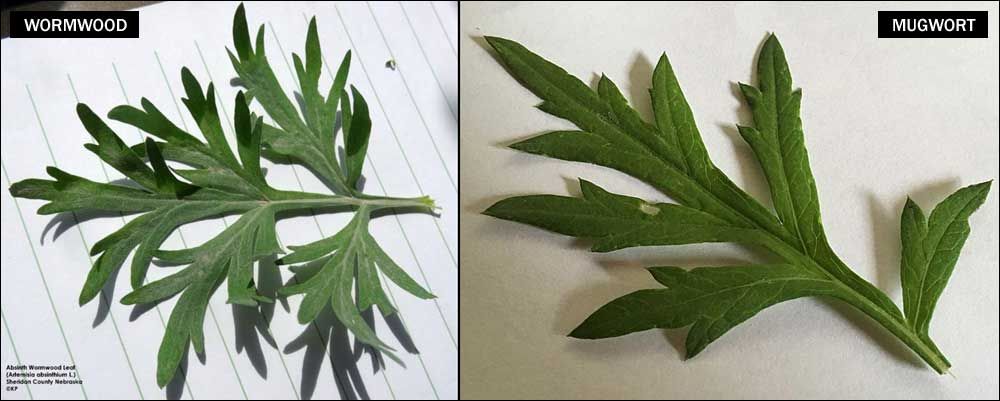Mugwort

BASIC IDENTIFICATION:
- Name: Common Mugwort, Artemisia vulgaris , also Mother or Maiden wort (early historic), Cronewood, Riverside Wormwood, St John's plant (not St John's wort).

- General Description of the Plant: (to be added)
- Why We Grow This? (common uses): Primarily as a medicinal. Culinary as a seasoning, in brewing and as a tea.
- Historical Facts and Quotes: Traditionally associated with women and the menstrual cycle.
- Can Be Confused With: Mugwort is a member of the Artemisia family, which includes other medicinal herbs like Wormwood, Sweet Anne and Tarragon. Mugwort leaves have a sharper point to their tips than Wormwood. Also Mugwort leaves are green on top with a white underneath, Wormwood has a more silvery top and bottom.

- Cautions and Hazards: Mugwort pollen is a common cause of hay fever. Considered an invasive species in gardens, landscapes and farming.
MEDICINAL LORE:
Appetite and Digestion: Promotes both with the production of bile and acts as a mild purgative.
Menstrual Cycle: Traditionally used to regulate women's menstrual health and aid in child birth. Eases menstrual cramps and promotes menstrual blood flow.
Muscular Pain Relief: As a bath additive for gout, rheumatism, arthritis or tired muscles. Helps with muscle disorders like palsy, fits, epileptic and similar affections.
:
:
:
Methods of Use:
Cautions and Warnings: Excessive use can cause symptoms of poisoning. Spasms and minor pain. Can cause vivid dreaming.
CULTIVATION:
- Popular Variations and Cultivars (text) .
- Starting: from seed; from cutting; by root stock, rhizome, bulb, grafting; other While flowers produce seeds, primary plant expansion takes place by rhizome (root) systems.
- Bedding Out: Grows in large groups via rhizome (root) system. In gardens, isolate possibly via containers. Watch for accidental seed spread to other areas of the garden or lawn. Considered invasive.
- Best soil type: Found often in wet wastelands, like gullies and ditches by the road or pathways. In bushy areas.
- Sowing Season Habits: Perennial.
- Plant Health and Maintenance: Very hardy plant.
- Companion Planting N/A .
HARVEST
- Signs of ripeness, over- and under-ripe (text) .
- Gathering tips. Gloves, techniques Gather leaves when flowering but before they go to seed. Gather root in the Fall.
- Preserving and Storage Bundle leaves and stems, then hang in cool dry place. Roots should be washed in cool water then freed of rootlets. Dry in open warm air, spread thinly and turned regularly to prevent mold. Complete when dry to the core and brittle, snapping when bent.
- Post-harvest soil care and compostable wastes (text) .
COOKING AND EATING:
- Nutritional Information: (text) .
- How to prepare before eating: Usually leaves and roots are dried then ground into a powder.
- Useful recipes and cooking hints: (text) .
- Historical dishes and meals: Is sometimes used as a flavoring or bittering agent in non-hopped, fermented grain beverages. Green leaves are used as a stuffing for fowl. Also used as a recreational tea.
- Non-Food Usages: Primarily medicinal.
SEEDS
- How This Plant Propagates: Primarily through rhizome (root) systems, which are extensive but shallow (8 inches/20 cm). Single plants can spread out into large stands. Seeds are wind dispersed.
- Harvesting Seeds: Seeds are very small (0.03 in/ 1 mm), harvested from flowers.
- Seed Storage: Dry as typical.
OTHER INFO
- Green Wizard forum links
- Outside Links:
- Helpful Books
- Contributors
----
Admin note: will add more soon. I'm going to try and get a couple of these entries a month started for further discussion. Feel free to post your experience with this herb.
Justin Patrick Moore
Mon, 12/09/2019 - 06:58
Permalink
Mugwort Smudge
I have a mugwort patch in my yard and I use it along with our sage and lavender plants to make smudge sticks. A smudge of just mugwort I have found very useful in occult work -specifically as an adjunct for helping propel visionary experiences. It can also be used for lucid dreaming, but I find that it also has a stimulant quality... so that after first being used (in smudge form) it will induce dreams, but then you wake up and can't get back to sleep, hence it is better to be used in a ritual or meditation setting where there will also be a visionary component (you can also substitute the term visionary with astral projection / pathworking / journeying depending on your spiritual-magical system and its terminology). In this respect mugwort has been a great ally. I have no experience using it in any other setting / purpose as of yet.
Teresa from Hershey
Mon, 12/09/2019 - 11:37
Permalink
Is mugwort used (sort of) for birth control?
I ask because anything that 'regulates and promotes menstrual flow' is often used to promote a miscarriage.
If you don't want a miscarriage, then you'd best be careful.
Teresa from Hershey
David Trammel
Mon, 12/09/2019 - 12:48
Permalink
Still Reading Up On Mugwort's Usages.
This past year has been good for finding old and cheap copies of valuable books, including many on herbal medicine. It took me a bit to get what I do have up done. I wanted to get the taxonomy done first. Next up is to go through those books and get the medicinal information posted better and in more detail.
Your warning is good though to remember.